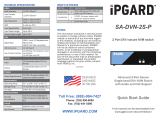Page is loading ...

TECHNICAL SPECIFICATIONS WHAT’S IN THE BOX
USB
Signal Type USB 1.1 keyboard and mouse only
USB Connectors
4-Port: (4) USB Type B;
4-Port w/CAC or 8-Port:
(8) USB Type B;
8-Port: (16) USB Type B;
User Console
Interface
All: (2) USB Type A for keyboard/mouse
connections;
4-Port w/CAC or 8-Port w/CAC:
(1) USB Type A for CAC
AUDIO
Input
4-Port: (4) Connector stereo 3.5 mm
female;
8-Port: (8) Connector stereo 3.5 mm
female;
Output (1) Connector stereo 3.5 mm female
POWER
Power
Requirements
12-VDC, 2-A power adapter with
center-pin positive polarity
ENVIRONMENT
Operating Temp 32° to 104° F (0° to 40° C)
Storage Temp -4° to 140° F (-20° to 60° C)
Humidity
0-80% relative humidity,
noncondensing
OTHER
Emulation Keyboard, mouse, and video
User Controls Front-panel buttons
PART NO. QTY DESCRIPTION
SKMN-4S 1 4-Port
SKMN-4S-P 1 4-Port with CAC
SKMN-8S 1 8-Port
SKMN-8S-P 1 4-Port with CAC
PS12VDC2A 1
12-VDC, 2-A power adapter with
center-pin positive polarity.
1 Quick Start Guide
SKMN-4S, SKMN-4S-P
SKMN-8S, SKMN-8S-P
4 or 8 Port secure KM switch
Advanced 4-Port or 8-Port
Secure KM Switch with Audio
with or without CAC Support
Quick Start Guide
DESIGNED
AND MADE
IN THE USA
NOTICE
The information contained in this document
is subject to change without notice. iPGARD
makes no warranty of any kind with regard
to this material, including but not limited to,
implied warranties of merchantability and
tness for a particular purpose. iPGARD
will not be liable for errors contained
herein, or for incidental or consequential
damages in connection with the furnishing,
performance, or use of this material. No
part of this document may be photocopied,
reproduced, or translated into another
language without the prior written consent
from iPGARD, Inc.
20170518
Toll Free: (888)-994-7427
Phone: (702) 800-0005
Fax: (702)-441-5590
WWW.iPGARD.COM
A full manual can be downloaded from
www.ipgard.com/documentation/

AUDIO OUT
VIDEO
USB IN
USB OUT
CAC IN
CAC OUT
AUDIO IN
SKMN-4S-P
1 2 3 4
SKMN-4S-P
AUDIO OUT
VIDEO USB IN
USB OUT
CAC IN
CAC OUT
AUDIO IN
SKMN-8S-P
SKMN-8S-P
1 2 3 4 5 6 7 8
DESIGNED
AND MADE
IN THE USA
EDID LEARN HARDWARE INSTALLATION
FIGURE 1. 4-PORT APPLICATION
DIAGRAM
FIGURE 2. 8-PORT APPLICATION
DIAGRAM
After connecting all devices to the SKMN, a default
display topology conguration and display mode
will be in effect. By default the SKMN is congured
to single-head mode and a topology with 4 screens
arranged horizontally starting with port 1 on
the lefthand side. If a different display topology
conguration and display mode is desired. See the
full manual for details on available settings.
The installation setup must match one of the SKMN’s
predened display topology congurations. This can
be selected through keyboard hotkey commands.
Please refer to “Display Topology Conguration” in
the full manual for the available display topologies.
If one or more of the input computers have multiple
displays, the “Multi-Head Display Mode” must be
selected. Otherwise, select Single-Head mode.
Optional display topology
SYSTEM REQUIREMENTS
1. iPGARD Secure PSS is compatible with standard
personal/portable computers, servers or thin-
clients, running operating systems such as
Windows or Linux.
2. The peripheral devices that are supported by the
KM are listed in the following table:
CONNECTING THE SKMN
1. Ensure that power is turned off or disconnected
from the unit and the computers.
2. Use a USB cable (Type-A to Type-B) to connect
a USB port on each computer to the respective
USB ports of the unit.
3. Optionally connect a stereo audio cable (3.5 mm
to 3.5 mm) to connect the audio output of the
computers to the AUDIO in ports of the unit.
4. Connect a USB keyboard and mouse in the two
USB console ports.
5. Optionally connect stereo speakers to the
audio out port of the unit.
6. Optionally connect CAC (COMMON ACCESS CARD,
SMART CARD READER) to the CAC port in the
user console interface.
7. Power on the KM by connecting a 12VDC power
supply to the power connector, and then turn on
all the computers.
Note: The computer connected to port 1 will always
be selected by default after power up. You can
connect up to 4 computers to the 4 port KM.
Cursor
Auto-switch
from 4 to 1
Auto-switch
from 1 to 2
Auto-switch
from 2 to 3
Auto-switch
from 3 to 4
Monitor 4
Monitor 3Monitor 2
Monitor 1
Auto-Switch
From 2 to 3
Cursor Movement
Auto-Switch
From 3 to 4
Auto-Switch
From 4 to 5
Auto-Switch
From 8 to 1
Auto-Switch
From 7 to 8
Auto-Switch
From 6 to 7
Auto-Switch
From 5 to 6
Auto-Switch
From 1 to 2
Monitor 2
Monitor 1
Monitor 3
Monitor 8
Monitor 4
Monitor 7
Monitor 5
Monitor 6
Console Port Authorized Devices
Keyboard
Wired keyboard and keypad
without internal USB hub or
composite device functions
(unless the connected device has
at least one endpoint which is
a keyboard or mouse HID class,
KVM/KM extender).
Audio out
Analog amplied speakers,
Analog headphones, Digital audio
appliance.
Mouse/Pointing
Device
Any wired mouse or trackball
without internal USB hub or
composite device functions,
Touch-screen, Multi-touch or
digitizer, KVM/KM extender.
User
Authentication
Device
Smart-card reader, PIV/CAC
reader, Token or Biometric reader
/



